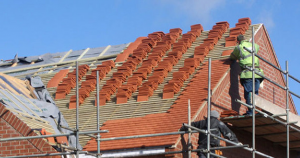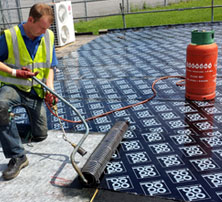
Pitched Roof vs Flat Roof
Flat roofs are basically a horizontal base fixed to the building’s ceiling joists covered with a waterproof membrane. To allow water to drain from the roof, a flat roofs construction is slightly pitched by just a couple of degrees. Flat roofing is both economic and efficient, which saves the owner energy and money. Roofs with little-to-no pitch are commonplace among commercial buildings, but are also present in some residential buildings.
Pitched roofs generally have a pitch of at least 15°. A typical roof pitch in the UK will be 40°-50° but at the extreme can go up to 70° (above 70° would most likely be called a wall!). However the construction is typically more complex and many architects shy away from 45° citing it as ugly preferring to adhere to the Golden Ratio of about 1:1.62.
From an architectural standpoint there is a good reason to install a pitched roof here in the UK: rain, snow and other elements of weather can simply slide down them. Since a flat roof is more or less flat it requires more intricate water drainage and gutter systems. Controlling water flow on flat roofs is not quite as easy as it is with sloped roofs.
Proper drainage must always be in place to get rid of water accumulation on any roof (guttering on pitched roofs and, as detailed above, more intricate solutions if the roof is flat). Many older flat roofs are not levelled, and water puddles can cover different areas of the rooftop after heavy rain and sit there until it dries out (or leaks). In some cases tapered insulation systems or internal drains would need to be added to allow for proper water flow from your building to ensure the longevity of your roofing system.
In this article we will examine some of the potential problems associated with flat roofs vs pitched roofs.
Pros and Cons
The fundamental design of your roof can have a range of different impacts on the function, aesthetic and ultimately the value of your property. If you’re looking to have a new roof installed on your home or business premises, the decision between a flat roofed or a pitched roof can be a tough one.
There are advantages and disadvantages to both, so here is an overview of the pros and cons of each so you will have a better idea of which would be most suitable for your particular property.
Pitched roofing
Pros
- The traditional domestic roofing solution here in the UK and they are still popular today.
- They are versatile and can look fantastic.
- They can be converted to house substantial extra living space inside, including:
- Attic bedrooms
- Bathrooms
- Playrooms
- Storage rooms
- Offices
- Attic conversions can make your home more appealing for future buyers.
- Pitched roofs are known for their longevity and durability
- Pitched roofs are also more reliable when it comes to drainage, with water naturally channelled into downpipes and guttering
- Pooling water is less of a risk.
Cons
- The initial cost of construction can be comparatively high.
- Pitched roofs also take more time to install.
Flat roofing
Pros
- Flat roofs can be built to accommodate foot traffic.
- Particularly desirable for commercial properties.
- Flat roofs are typically at their best on smaller buildings.
- Ideal for extensions and garages.
- A flat roofs construction is quicker and easier to install than pitched roofing.
- Much cheaper design and installation costs compared to pitched roofs.
- Flat roofs can be the ideal canvas for an eco-friendly green roof.
Cons
- Flat roofs typically require more hands-on attention to ensure they are performing to their fullest for as long as possible.
- Drainage is often less efficient. This can, however, be offset with a green roof, or a dedicated drainage solution, so you should talk to your roofing contractor to see if this approach is viable for you.
Aesthetics
Both pitched and flat roofs offer a unique visual appeal for any property. Pitched roofing is seen as the more traditional option, while flat roofing is popular with modern and contemporary designs. Both roofing styles can be constructed with metal materials, and metal pitched roofs can be an excellent blend of traditional and modern designs. Slates on pitched roofs can add a timeless feel and in some parts of the UK are a prerequisite so be sure to check local planning restrictions. A roofing company like Dobson Roofing Sheffield will be happy to assist you here.
Flat roofing commonly has a neat, sleek and compact appeal. For commercial properties, a flat roof can create a strong modern atmosphere. This can help strengthen the image of the business as a whole, and can be influential if you’re planning to undergo a rebranding or redesign of your property.
Conclusion
While the choice to opt for a flat or pitched roofing solution is always going to be based on the individual project requirements. It can sometimes be just down to aesthetics, cost or timeframe. We hope that this article helps you to make an informed decision on the roof that you best suit your requirements. If you have any further questions or would like to find a roofer here in the UK then feel free to call Dobson Roofing on 01246 411 088.
